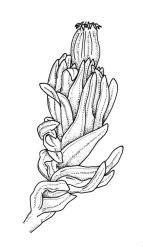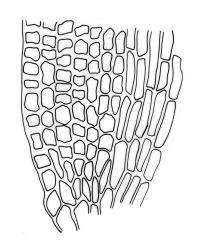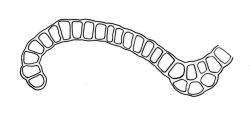- = Orthotrichum brevirostrum R.Br.bis, Trans. & Proc. New Zealand Inst. 27: 437 (1895)
- = Orthotrichum pseudopumilum Venturi, Rev. Bryol. 23: 67 (1896)
- = Orthotrichum ligulatum Müll.Hal., Hedwigia 37: 140 (1898)
Plants small, 5–10 mm, forming ± dense tufts, green to olive-green above, brown to almost black below. Stems branched by innovation, with rhizoids well-developed near base. Leaves erect-appressed or slightly curved around the stem when dry, erect-spreading when moist, mostly ovate-lanceolate, broadly obtuse, broadly rounded or rarely rounded-acute at apex, not plicate, entire, strongly recurved to revolute for most of length on one or both sides, (2.2–)2.4–2.9 × (0.4–)0.6–1.0 mm; mid and upper laminal cells irregular or ± isodiametric, mostly wider than long, incrassate, indistinctly papillose (usually visible only when cells are viewed on edge) or smooth, 6.4–12.8 × 6.4–14.4 µm, becoming longer and less opaque below and grading into the basal cells; basal interior cells mostly oblong-rectangular, rather thin-walled, not or weakly-porose, (32–)38–80 × 6.4–15 µm, 4–6 rows at margins short rectangular and with thickened transverse walls. Costa as per genus. Gemmae absent.
Gonioautoicous. Perichaetial leaves not differentiated from vegetative. Capsules emergent or occasionally immersed, pale yellow-brown, narrowly cylindric with 8 deep furrows for their full length and slightly constricted below the mouth when dry, nearly smooth and cyathiform when moist, 1 per perichaetium; exothecial cells differentiated into 16 alternating bands of thick- and thin-walled cells, the thick-walled bands 5–6 cells wide and forming ridges when dry, mostly rectangular; stomata superficial, restricted to mid urn; operculum as per genus. Peristome double; exostome teeth 8, hyaline, yellow or light brown, recurved when dry, finely papillose and with the papillae increasing in height towards the tooth apex; preperistome absent; endostome segments 8, 1–2 cells wide at the base, almost as tall as the exostome, incurved when dry, hyaline and finely papillose. Calyptra campanulate-mitrate, yellow-brown, with the apex ± red and sometimes with red-brown striae below, plicate and ± split near the base, smooth, naked. Spores globose, isosporous and 1-celled, yellow-brown, 16–22.5 µm, papillose.
Orthotrichum cyathiforme can easily be confused with O. assimile, given that both species have narrowly cylindric, ribbed capsules and recurved peristomes when dry. The leaves in O. cyathiforme are usually more broadly obtuse or rounded apically compared to those of O. assimile. It is necessary to observe the stomata (superficial in O. cyathiforme; deeply immersed in O. assimile) to be certain of the identity of these plants; sterile material cannot be determined with confidence.
Sainsbury (1955, p. 211) stated that O. cyathiforme bears a strong but superficial resemblance to O. hortense; both have superficial stomata. Lewinsky (1984, p. 429) considered that the two species are easily separated by several features, including leaf shape, the nature of their laminal cells, and calyptra hairiness.
NI: S Auckland (near Barryville), Hawke’s Bay (Wairoa, Puketītiri Road, near Napier), Wellington; SI: Marlborough, Canterbury, Otago, Southland.
Endemic. Orthotrichum cyathiforme is most common in eastern and southern parts of the South I. and does not extend northward of c. 38°S (the approximate latitude of Hamilton). Lewinsky (1984, p. 428) provided a detailed distribution map.
Mainly epiphytic but rarely collected from non-calcareous rock. Lewinsky (1984, table 1) recorded it as epiphytic on six genera of native and at least nine genera of introduced woody plants. On the North I. ranging from sea level to 580 m (Puketītiri Road); on the South I. ranging to at least 470 m (Blue Duck Scenic Reserve, Marlborough L.D.).
The combination of the broadly obtuse and erect-appressed leaves, naked calyptra, and mostly emergent, strongly ribbed capsules with reflexed, dry peristome teeth make O. cyathiforme one of the most distinctive and easily recognised species of Orthotrichum in N.Z. Lewinsky’s (1984, p. 429) comments that the leaves are completely smooth are misleading. While in surface view the laminal cells usually appear smooth, low (less than 4 µm high) papillae are present in all material I have examined (including type material). The papillae are usually visible when the upper laminal cells are viewed on edge; however, the material illustrated in Image: Image\2FAZ, fig. L, lacks papillae.
Plants belonging to O. cyathiforme were often determined by early collectors as O. pumilum Sw., a plant of the northern hemisphere with immersed stomata.
A critical collection by William Bell (part of which is the type of Orthotrichum pseudopumilum Vent.) is the source of considerable confusion. W. Bell 643 is probably an aggregated collection (there are duplicates of Bell 643 in the Beckett herbarium, and these include at least three different Orthotrichum spp.). It is possible that part of the collection came from trees and part from rock (judging from the assortment of species present in various duplicates). Lewinsky cited a duplicate in BM as an isotype of Venturi’s O. pseudopumilum, which she placed in the synonymy of O. cyathiforme R.Br.bis. There is some O. cyathiforme present in one duplicate in the Beckett herbarium, but not in the other. It would be pointless to question Lewinsky’s synonymy.










